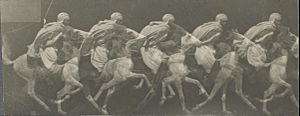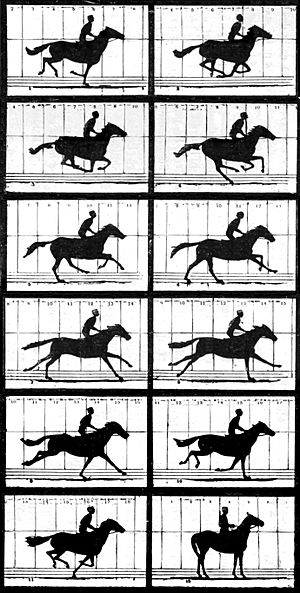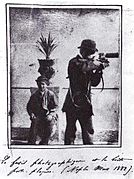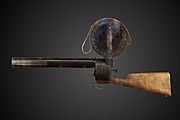Étienne-Jules Marey facts for kids
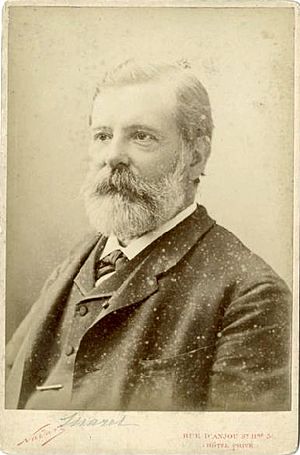
Étienne-Jules Marey (born March 5, 1830, died May 15, 1904) was a French scientist. He was a physiologist, which means he studied how living things work. He also became a pioneer in Chronophotography, a way of taking many photos quickly to show movement.
Marey's work was very important for many fields. These include cardiology (the study of the heart), making scientific tools, aviation (flying), cinematography (making movies), and laboratory photography. Many people see him as a key figure in the early days of photography and a major pioneer in the history of cinema. He also created new ways to show and understand scientific data using graphs.
Biography
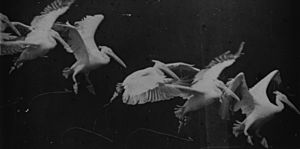
Marey first studied how blood moves in the human body. Later, he focused on heartbeats, breathing, muscles, and body movements. To help with his studies, he invented many tools for exact measurements.
For example, in 1859, he worked with another scientist, Auguste Chauveau, and a watchmaker, Breguet. Together, they made a special device called a Sphygmograph. This tool could be worn to measure a person's pulse. It was a much better version of an older, harder-to-use design.
Studying Animal Movement
In 1869, Marey built a very delicate artificial insect. He used it to show how an insect flies. He proved that an insect's wings move in a figure-8 shape. He even attached gold foil to an insect's wing and shone light on it to study its flapping.
He then became very interested in how air moves. He started to study larger flying animals, like birds. Marey developed a special type of photography called chronophotography in the 1880s. His big idea was to record many different stages of movement on just one photograph.
In 1890, he published a large book called Le Vol des Oiseaux (The Flight of Birds). It had many photos, drawings, and diagrams. He also made incredibly detailed sculptures of various flying birds.
Marey also studied other animals. In 1873, he published a book called La Machine animale (Animal Mechanism). The English photographer Eadweard Muybridge later did his famous "Photographic Investigation." This study aimed to prove that Marey was right about a galloping horse. Marey had written that a galloping horse briefly has all four hooves off the ground. Muybridge's photos, published in 1879, confirmed this.
Marey wanted to combine anatomy (the study of body structure) with physiology (the study of how bodies work). To understand his chronophotographs better, he compared them to images of animal anatomy. This included their skeletons, joints, and muscles. He even made drawings showing a horse trotting and galloping, first as it looked, then as a skeleton.
Marey spent time in Naples, Italy, for his studies. He even bought a villa there. He used the Stazione Zoologica Anton Dohrn, a famous research station, to study fish movement in their aquariums. He once asked them for live ray fish for his research. People in Naples sometimes called him "the silly from Posillipo." This was because he used his chronophotographic gun to aim at birds without shooting them, which seemed strange to them.
Chronophotography
Marey's chronophotographic gun was created in 1882. This amazing tool could take 12 pictures every second. All these pictures were recorded on the same photographic plate. He used these photos to study many animals. These included horses, birds, dogs, sheep, donkeys, elephants, fish, tiny creatures, molluscs, insects, and reptiles. Some people called it Marey's "animated zoo."
Marey also did a famous study about how cats always land on their feet. He did similar studies with chickens and dogs and found they could do almost the same thing. Marey also studied how humans move. In 1894, he published another book called Le Mouvement (Movement).
- Marey's chronophotographic gun
-
Marey's photographic gun, on display at the Conservatoire national des arts et métiers.
Marey also made early movies. They were very fast, capturing 60 images per second, and had excellent quality. His research on how to capture and show moving images greatly helped the new field of cinematography.
Towards the end of his life, he returned to studying the movement of simple things, like a falling ball. His last big project involved observing and photographing smoke trails. This research helped create one of the first aerodynamic wind tunnels. He built a smoke machine with 58 smoke trails in 1901.
See also
 In Spanish: Étienne Jules Marey para niños
In Spanish: Étienne Jules Marey para niños
- Eadweard Muybridge (1830-1904)
- Chronophotography
- Velocimetry


